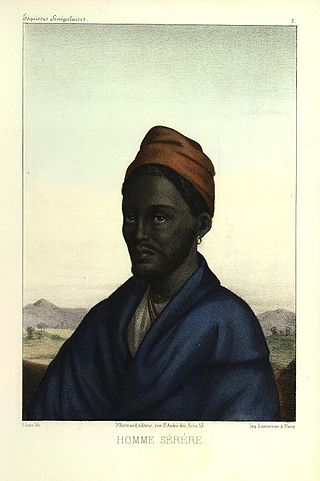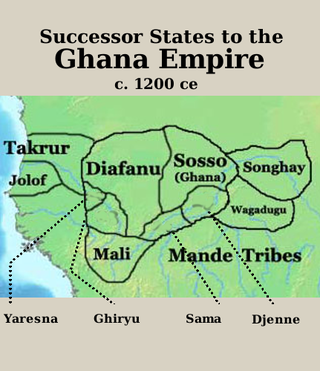Wolofization or Wolofisation is a cultural and language shift whereby populations or states adopt Wolof language or culture, such as in the Senegambia region. In Senegal, Wolof is a lingua franca [1] [2] [3] The Wolofization phenomenon has taken over all facets of Senegal and encroaching on Gambian soil. [3] This phenomenon has caused other Senegambian ethnic groups great concern and resulted in taking steps to preserve their languages and culture. In this regard, the Serer ethnic group who have had a long history fighting against Islamization and Wolofization have been taking active steps in the past decades by setting up associations and other organisations in order to preserve their languages, culture and "ancient religious past." [4] [5] [6] Haalpulaar speakers, namely the Fula and Toucouleur have also been taking steps to preserve their language. [7]
Many people argue that since Wolof is the lingua franca in Senegal, it should be the official language. [8]
The Wolofization phenomenon taking place in Senegal and encroaching on Gambian soil has been criticised by many Serer, Mandinka and Haalpulaar (Fula and Toucouleur) intellectuals. [9] [4] [10] [11] [12] [13] Serer historian and author Babacar Sedikh Diouf view Wolofization as destructive to the languages and cultures of the other Senegambian ethnic groups such as Serer, Jola, Mandinka, Fula, etc., and calls for a "controlled osmosis" between Wolof and other ethnicities. In his view, Diouf regards Wolofization as a form of “uncontrolled” homogenization of Senegal by the Wolof. [11] [12] [9] His fellow Serer intellectual Marcel Mahawa Diouf, along with Mandinaka intellectual Doudou Kamara, and Haalpulaar intellectuals Yoro Doro Diallo and Cheikh Hamidou Kane share Diouf's sentiments. [9] The historian and author Marcel Mahawa Diouf offers a more drastic solution for dealing with the "Wolofization problem". Since the Wolof are a mixture of the various ethnic groups of the Senegambia region, and that, even their language (the Wolof language) is not actually the language of the Wolof in origin, but the original language of the Lebu people, Marcel Mahawa calls for an alliance between all non-Wolofs who have had historic alliances with each other. In effect, that would be the Serers, Toucouleurs, Soninke people (Sarakolés), Sossés (Mandinka), Jola, and Lebou. The sole purpose of revisitng these ancient alliances (where one tribe calls for help and another answers, commonly known in Senegambia as gamo, from the old Serer term gamohou or gamahou ("to find the lost heart", itself an ancient Serer religious festival [14] ) is to disconnect the Wolof thereby disinheriting them from the Senegambia region and its history. [9]

Senegal, officially the Republic of Senegal, is the westernmost country in West Africa, situated on the Atlantic Ocean coastline. Senegal is bordered by Mauritania to the north, Mali to the east, Guinea to the southeast and Guinea-Bissau to the southwest. Senegal nearly surrounds The Gambia, a country occupying a narrow sliver of land along the banks of the Gambia River, which separates Senegal's southern region of Casamance from the rest of the country. Senegal also shares a maritime border with Cape Verde. Senegal's economic and political capital is Dakar.

The Kingdom of Saloum was a Serer kingdom in present-day Senegal as well as parts of Gambia, then called Lower Saluum. The precolonial capital of Saloum was the city of Kahone. It was a sister to the Kingdom of Sine. Their history, geography and culture were intricately linked and it was common to refer to them as the Sine-Saloum and the Serer Kingdoms of Sine and Saloum.

The Serer-Ndut or Ndut also spelt are an ethnic group in Senegal numbering 38600. They are part of the Serer people who collectively make up the third largest ethnic group in Senegal. The Serer-Ndut live mostly in central Senegal in the district of Mont-Roland, northwest of the city of ancient Thiès.

Takrur, Tekrur or Tekrour was a state based in the Senegal River valley in West Africa which was at its height in the 10th and 11th centuries, roughly parallel to the Ghana Empire, but lasted in some form into the 18th century.
The Senegambia is, in the narrow sense, a historical name for a geographical region in West Africa, which lies between the Senegal River in the north and the Gambia River in the south. However, there are also text sources which state that Senegambia is understood in a broader sense and equated with the term the Western region. This refers to the coastal areas between Senegal and Sierra Leone, where the inland border in the east was not further defined.

The music of the Gambia is closely linked musically with that of its neighbor, Senegal, which surrounds its inland frontiers completely. Among its prominent musicians is Foday Musa Suso. Mbalax is a widely known popular dance music of the Gambia and neighbouring Senegal. It fuses popular Western music and dance, with sabar, the traditional drumming and dance music of the Wolof and Serer people.

The Toucouleur people or Tukulor people, also called Haalpulaar, are a West African ethnic group native to the Futa Toro region of Senegal. There are smaller communities in Mali and Mauritania. The Toucouleur were Islamized in the 11th century; their early and strong Islamic heritage, which is seen as a defining feature, is a "matter of great pride for them". They were among the first Muslims in the area that became Senegal. They were influential in the spread of Islam to West Africa in the medieval era.

The Wolof, the largest ethnic group in Senegal, have a distinctive musical tradition that, along with the influence of neighboring Fulani, Tukulor, Serer, Jola, and Malinke cultures, has contributed greatly to popular Senegalese music, and to West African music in general. Wolof music takes its roots from the Serer musical tradition, particularly from the Serer pre-colonial Kingdom of Saloum. Virtually all Wolof musical terminology including musical instruments comes from the Serer language.

The Jola or Diola are an ethnic group found in Senegal, the Gambia, and Guinea-Bissau. Most Jola live in small villages scattered throughout Senegal, especially in the Lower Casamance region. The main dialect of the Jola language, Fogni, is one of the six national languages of Senegal.

Senegal is a multilingual country: Ethnologue lists 36 languages, Wolof being the most widely spoken language.
Daniel Laemouahuma Jatta is a Jola scholar and musician from Mandinary, Gambia, who pioneered the research and documentation of the akonting, a Jola folk lute, as well as the related Manjago folk lute, the buchundu, in the mid-1980s. Prior to Jatta's work, these instruments were largely unknown outside the rural villages of the Senegambia region of West Africa.

The Serer people are a West African ethnoreligious group. They are the third-largest ethnic group in Senegal, making up 15% of the Senegalese population. They are also found in northern Gambia and southern Mauritania.

The Kingdom of Sine was a post-classical Serer kingdom along the north bank of the Saloum River delta in modern Senegal. The inhabitants are called Siin-Siin or Sine-Sine.

There are various ethnic groups in Senegal. According to "CIA World Factbook: Senegal", the ethnic groups are Wolof (39%); Fula (27.5%)); Serer group ; Mandinka (4.9%); Jola (4.2%); Soninke (2.4%); other 5.4%, and other minor ethnic groups like the Bassari, Maures or (Naarkajors)). Many subgroups of those can be further distinguished, based on religion, location and language. According to one 2005 estimate, there are at least twenty distinguishable groups of largely varying size.
The French conquest of Senegal started in 1659 with the establishment of Saint-Louis, Senegal, followed by the French capture of the island of Gorée from the Dutch in 1677, but would only become a full-scale campaign in the 19th century.
Maad a Signig Kumba Ndoffene Famak Joof was the King of Sine in modern-day Senegal. Maad a Sinig means king of Sine. He ruled from 1853 until his death on 23 August 1871. He was the son of Maad Souka Ndela Joof and Lingeer Gnilane Jogoy Joof. His father – Maad Souka Ndela came from The Royal House of Semou Njekeh Joof founded by Maad Semou Njekeh Joof in the early 18th century, which was the third and last Royal House of Joof family of Sine and Saloum. His paternal family ruled three Kingdoms : Sine, Kingdom of Saloum and previously the Kingdom of Baol. They descended from Maad Ndaah Njemeh Joof the 13th century King of Lâ (Laah) in Baol.
Guelowar, also spelled Gelwar, Guelwar, Guelware, Gueleware or Gueloware, was a maternal dynasty in the pre-colonial Serer kingdoms of Sine and Saloum. They were from the Mandinka ethnic group. The offspring of Mandinka women and Serer men became the kings of Sine and Saloum. The dynasty lasted from the mid-14th century to 1969, the year both kings died.

The medieval history of the Serer people of Senegambia is partly characterised by resisting Islamization from perhaps the 11th century during the Almoravid movement, to the 19th century Marabout movement of Senegambia and continuation of the old Serer paternal dynasties.
This is a timeline of the history and development of Serer religion and the Serer people of Senegal, The Gambia and Mauritania. This timeline merely gives an overview of their history, consisting of calibrated archaeological discoveries in Serer countries, Serer religion, politics, royalty, etc. Dates are given according to the Common Era. For a background to these events, see Roog, Serer religion, Serer creation myth, Serer prehistory, Lamane, States headed by Serer Lamanes, Serer history and Serer people.
Babacar Sedikh Diouf or Babacar Sédikh Diouf is a Senegalese historian, author, researcher, campaigner against "Wolofization", a Pan-Africanist, and former teacher. He has written extensively about the history and culture of Senegal, Africa, and that of the Serer ethnic group to which he belongs. He usually writes by the pen name Babacar Sedikh Diouf.